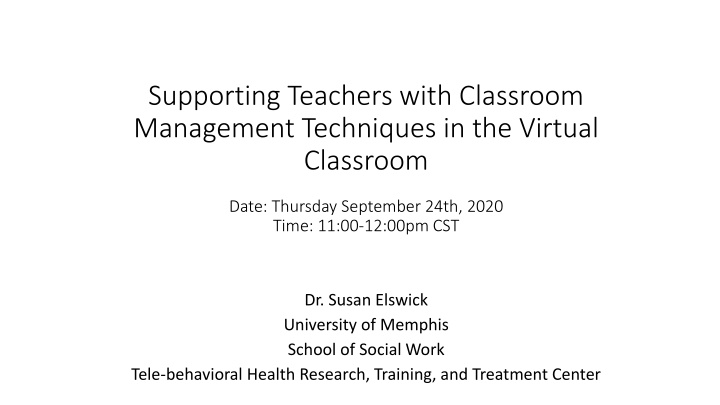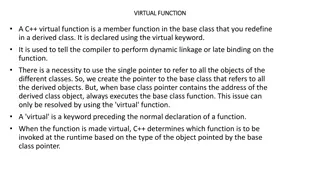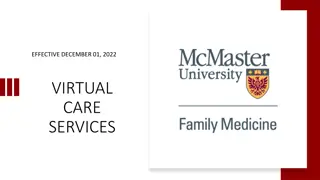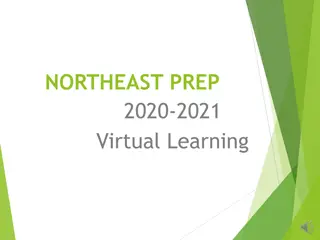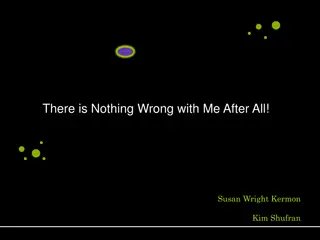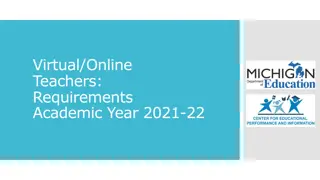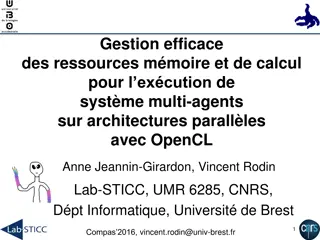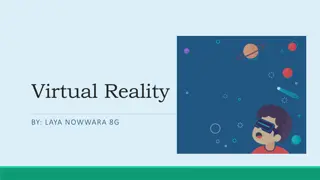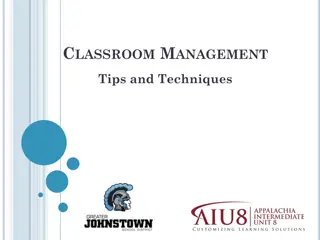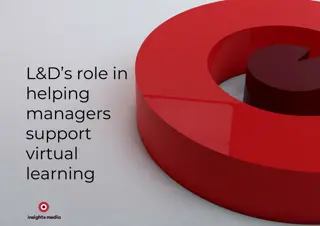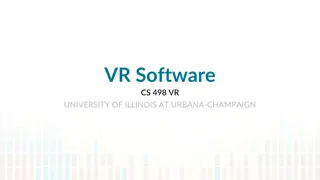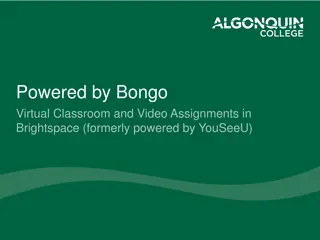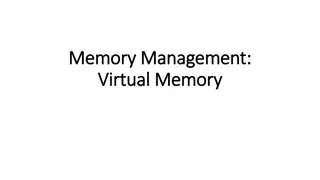Virtual Classroom Management Techniques Workshop with Dr. Susan Elswick
Join Dr. Susan Elswick from the University of Memphis School of Social Work for a workshop on supporting teachers with classroom management techniques in the virtual classroom. Learn about strategies to help students struggling in virtual platforms, ways to support social-emotional and behavioral needs, and how to assist educators in the online teaching environment. Gain insights on assessing student needs globally and understanding the impact of remote learning on academic outcomes and caregiver support. Enhance your skills in virtual classroom management with practical tips and expert guidance.
Download Presentation

Please find below an Image/Link to download the presentation.
The content on the website is provided AS IS for your information and personal use only. It may not be sold, licensed, or shared on other websites without obtaining consent from the author.If you encounter any issues during the download, it is possible that the publisher has removed the file from their server.
You are allowed to download the files provided on this website for personal or commercial use, subject to the condition that they are used lawfully. All files are the property of their respective owners.
The content on the website is provided AS IS for your information and personal use only. It may not be sold, licensed, or shared on other websites without obtaining consent from the author.
E N D
Presentation Transcript
Supporting Teachers with Classroom Management Techniques in the Virtual Classroom Date: Thursday September 24th, 2020 Time: 11:00-12:00pm CST Dr. Susan Elswick University of Memphis School of Social Work Tele-behavioral Health Research, Training, and Treatment Center
Susan Elswick EdD LCSW Dr. Elswick is an Associate Professor at the University of Memphis in the School of Social Work. She is the School Social Work Certificate Coordinator for the University of Memphis. Dr. Susan Elswick has over 16 years of clinical mental health experience that includes community mental health, case management, residential programming, school-based programming, integrated behavioral health, infant mental health, and home-based services. One of her areas of research focuses on the use of informatics and technology in the field of social work. Dr. Elswick serves as the Co-chair for the Council on Social Work Education (CSWE) Annual Program Review Technology Track that focuses on harnessing technology for social good in behavioral health practice, and she is a current Faculty Affiliate on campus at University of Memphis with the Institute for Intelligent Systems (IIS). Most recently, she is a Co-PI on the U of M s $2.58 million National Science Foundation (NSF)-funded project, which will lay the foundation for a future Learner Data Institute (LDI) at the university.
Learning Objectives Participants will learn... Why some students will struggle in a virtual platform Techniques to support classroom management in the virtual world Ways in which school social workers and educators can embed practices to support the social-emotional and behavioral needs of students and support teachers in the virtual classroom
Assessing Student Needs Globally
Why will some students struggle This shift from traditional educational practices to more remote learning will have an impact on student outcomes. This shift will impact the level of support needed to be offered to virtual learners: academically; will impact the learning activities that meet the needs of all learners based on learning style preferences; will impact the level of social-emotional and behavioral supports offered in traditional classroom settings; and the need for caregivers to have necessary digital literacy skills in order to support the needs of their children.
Learning Styles Students use to a traditional school setting may have to adjust to not having a teacher standing in front of them for immediate feedback. Learning styles of individual students must be taken into consideration when determining needs of each student. The term learning styles speaks to the understanding that every student learns differently. Technically, an individual s learning style refers to the preferential way in which the student absorbs, processes, comprehends and retains information (Cerbin, 2011).
Learning Styles Visual Auditory Kinesthetic Reading/Writing Assessments for Identifying Learning Styles: http://www.educationplanner.org/students/self-assessments/learning- styles-quiz.shtml
Visual Learner How to recognize visual learners in your class: Someone with a preference for visual learning is partial to seeing and observing things, including pictures, diagrams, written directions and more. This is also referred to as the spatial learning style. Students who learn through sight understand information better when it s presented in a visual way. These are your doodling students, your list makers and your students who take notes. How to cater to visual learners: The whiteboard or smartboard is your best friend when teaching these types of learners. Use share screen often and interactive board in virtual platform. Give students opportunities to draw pictures and diagrams on the board or ask students to doodle examples based on the topic they re learning. Teachers catering to visual learners should regularly make handouts and use presentations. Visual learners may also need more time to process material, as they observe the visual cues before them. So be sure to give students a little time and space to absorb the information.
Auditory Learner How to recognize auditory learners in your class: Auditory learners tend to learn better when the subject matter is reinforced by sound. These students would much rather listen to a lecture than read written notes, and they often use their own voices to reinforce new concepts and ideas. These types of learners prefer reading out loud to themselves. They aren t afraid to speak up in class and are great at verbally explaining things. Additionally, they may be slower at reading and may often repeat things a teacher tells them. How to cater to auditory learners: Since these students generally find it hard to stay quiet for long periods of time, get your auditory learners involved in the lecture by asking them to repeat new concepts back to you. Ask questions and let them answer. Invoke group discussions so your auditory and verbal processors can properly take in and understand the information they re being presented with. Use Breakout sessions for this. Record your Lecture and allow for them to review later. Watching videos and using music or audiotapes are also helpful ways of learning for this group.
Kinesthetic Learner How to recognize kinesthetic learners in your class: Kinesthetic learners, sometimes called tactile learners, learn through experiencing or doing things. They like to get involved by acting out events or using their hands to touch and handle in order to understand concepts. These types of learners might struggle to sit still and often excel at sports or like to dance. They may need to take more frequent breaks when studying. How to cater to kinesthetic learners: The best way teachers can help these students learn is by getting them moving. Instruct students to act out a certain scene from a book or a lesson you re teaching. Also try encouraging these students by incorporating movement into lessons: pacing to help memorize, learning games that involve moving around the classroom or having students write on the whiteboard as part of an activity. Incremental movement breaks will be needed. Breakout groups and small class activities that engage them in movement activities. Once kinesthetic learners can physically sense what they re studying, abstract ideas and difficult concepts become easier to understand.
Reading/ Writing Learner How to recognize reading/writing learners in your class: Reading/writing learners prefer to learn through written words. While there is some overlap with visual learning, these types of learners are drawn to expression through writing, reading articles or books, writing in diaries, looking up words in the dictionary and searching the internet for just about everything. How to cater to reading/writing learners: Of the four learning styles, this is probably the easiest to cater to since much of the traditional educational system tends to center on writing essays, doing research and reading books. Be mindful about allowing plenty of time for these students to absorb information through the written word and give them opportunities to get their ideas out on paper as well.
The NEA indicated that technology is constantly emerging around us and should be an expected component of every student's learning experience. 21st century skills are embedded in most current K- 12 curriculum, but digital literacy should always be assessed for all learners. Digital literacy refers to an individual's ability to find, evaluate, and compose clear information through writing and other media on various digital platforms (Buckingham, 2010). Digital literacy is evaluated by an individual's grammar, composition, typing skills and ability to produce text, images, audio and designs using technology. Digital Literacy
Many nontraditional technology consumers that struggle with digital literacy will fall into a category that was described by one researcher as digital immigrant (Prensky, 2001). Digital Literacy- Digital Immigrants Digital immigrants are described as individuals that have not been totally immersed in technology practices, but they do embed some technology into their daily lives. Although digital immigrants are not as fluent in technological practices, with the guidance of the school support systems, digital supports, training, and effective coaching, even non- traditional technology consumers can be successful within an online educational program or with using technology. Assessing Student AND Parent Digital Literacy is the first step
Digital Literacy Activities Students will have more knowledge and skills with technology than their caregivers, but students will need support in understanding and utilizing effective and appropriate skills in the online learning platform and in the online world. Minecraft for Education has developed an online training and game- based program to teach digital citizenship. This would be an excellent activity to add to your teaching and lesson planning. This intervention can also be implemented in small group instruction for identified students who are struggling in the online classroom. If this is used as a tier 2 intervention for support, the school social worker could implement this intervention for identified students. The Digital Citizenship Minecraft mod was developed by a teacher and includes a teacher lesson plan, script, activities, and step-by-step process. This is appropriate for students ages 6 to 13 years of age. The activity aims to assist students with defining and demonstrating responsible digital citizenship within Minecraft and other digital environments. For more information about this lesson plan visit: https://education.minecraft.net/lessons/digital-citizenship-2
Zoom Exhaustion Since attending school virtually requires both time online as well as time offline to successfully complete required lessons, some students will find the amount of time required to be in front of a computer daunting and overwhelming. Many reports on cases of zoom exhaustion and virtual overload have been reported since the beginning of the pandemic. Zoom exhaustion will be real for many of students across the nation. Students who are experiencing technology exhaustion may report the following symptoms: easily distracted, easily off task by environmental stimuli, difficulty staying focused and attending to needed information, extreme fatigue, eye dryness, decreased interaction, difficulty sleeping at night, and class participation. Mindfulness techniques and incremental virtual education breaks will be necessary to support the needs of learners. Students will need to learn techniques to manage their health and well-being in the remote education environment.
Student Risk Screening Survey (SRSS)- Universal screening tools can be an excellent place to start in determining the behavioral, mental health, and social emotional needs of students. Social- Emotional Needs Assessment This is a tier 1 universal screenings to identify students in need early on in the academic year related to social-emotional and behavioral needs. Teachers assess various risk factors for each student in their classroom to determine who is at-risk. The SRSS is not a standalone assessment and it should not be used as a solo assessment. The SRSS should be used as one of many data sources to inform instruction and indicate student risk. More information about the SRSS universal screening tool can be found here: https://mimtsstac.org/evaluation/student- assessments/student-risk-screening-scale
Social-Emotional Needs
There is evidence to indicate that the coronavirus disease 2019 (COVID-19) pandemic has profound psychological and social effects on the community at large (Sher, 2020). The negative psychological effects of the pandemic will probably persist for months and years to come. Studies indicate that the COVID-19 pandemic is associated with distress, anxiety, fear of contagion, depression and insomnia in the general population and among healthcare professionals (Wang et al., 2019). Social isolation, anxiety, chronic stress and economic difficulties may lead to the development or exacerbation of depressive, anxiety, substance use and other psychiatric disorders in vulnerable populations (Qui et al, 2020). Statistics on Student Social- Emotional Needs
Behavioral needs and concerns of students do not disappear just because the brick and mortar schoolhouse is no longer the avenue to provide services. Some educators believe that the virtual learning environment will assist teachers in the management of distractions occurring in traditional classrooms (talk out, out of seat, roaming, physical aggression, etc.); however, the virtual classroom will have many of these same struggles with less ability for the teacher or support staff to intervene in an effective manner. Virtual classroom settings will not eliminate these behavioral challenges and actually schools who decide not to include behavioral health supports as part of their programming are putting many students at-risk for further life disruptions by not supporting their needs earlier in development. Many barriers are broken down by offering school-based services including tele-behavioral health during the COVID-19 pandemic. **Classroom Management support*** The Need for Social- Emotional Supports to Continue- EVEN IN A VIRTUAL WORLD
Supportive Practices
Creating Structure and Consistency Develop Daily Agendas and Create Predictability- In times of uncertainty, children need consistency and predictability. Providing predictability assists in grounding the student and regulating their nervous system, because they know what to expect. Teachers can create predictability in the virtual classroom setting by keeping a daily agenda/ schedule and using a similar schedule daily. Starting each class by sharing your class schedule, agenda, and planned activities is a great place to start. For more ideas on how to develop a consistent and predictable classroom you can visit https://www.pbis.org/topics/classroom-pbis
Students need rules and expectations in the virtual classroom just like they do in the brick and mortar buildings. Start the year off right by utilizing Positive Behavioral Interventions and Supports (PBIS) techniques for developing classroom rules and expectations. Teachers should lay some ground rules but allow the students to also identify rules of the online class. Rules and expectations should be displayed and reviewed each day in the beginning of the class as a prompt and reminder. Teachers can use the screen share system in their online platform to display the classroom rules visually as they verbally review them in the beginning of each class. For more about setting up effective classroom rules and expectations visit this site: https://www.pbisworld.com/tier- 1/review-pbis-expectations-and-rules/ Developing Class Rules and Expectations
Virtual Break Card Working with the students to develop a cue, prompt, or break card procedure for requesting more time off screen will help to increase student communication skills, autonomy, and their feeling of being in control of their educational environment. It is important to know what times of day, classes, or content the student might ask for more breaks. Break cards work best when they are based on student functions of behavior, and a functional behavior assessment can assist with developing a strong break card procedure. Break card procedures in the virtual world can be as simple as the student holding up a red card as a prompt to show the teacher, they are requesting a break. Once the teacher acknowledges the request, he/she messages the student (through the chat box) to first thank them for asking for a break, and then to let the student know if they can take a break and for how long. If the student is offered a break after the request, the teacher must ensure that it is for a finite amount of time (no more than 2 minutes). The teacher can place this student in an individual break out room for the allotted time so that the student is automatically brought back to class when the timer ends. When the student returns within the time allotted, the teacher should message the student thanking them for returning. Also consider allowing Camera Off times throughout the day For more information about setting up a break card procedure click this link https://ed-psych.utah.edu/school- psych/_documents/Break-Cards-How-to-Use-Them.pdf
Decreasing Zoom Exhaustion with Break Activities- Embedding effective kinesthetic activities and movement tips will benefit the students and break up the monotony of the academic virtual day. Movement activities can be as simple as stretching together, doing simple yoga stretches, or more advances game-like movement activities. For some simple examples of movement-based break activities check out this website: https://blog.reallygoodstuff.com/getting-the- wiggles-out-3-movement-activities-you-cant- live-without/ Break Activities- Grounding Practices
Virtual Social Skills Activities Virtual Social Skills Opportunities- There are a number of evidence -based social skills curriculum that can be used in schools. Many of these evidence-based programs can easily be adapted to the virtual environment. Setting specific times throughout the day to embed these social skills curriculum and activities will greatly benefit the learner. It may also help if the school social worker for the school can have a slotted time during the day to engage with the learners utilizing an evidence-based social skills intervention to ensure that these connections are still made in the virtual environment. For a list of supportive and evidence-based social skills curriculum click this link: https://ies.ed.gov/ncee/wwc/Intervention/763 Teachers can support social skill development through structured social interventions during break sessions throughout the day or even offering a group- based activity aimed at enhancing social skills interaction within the virtual world. Minecraft for education also includes a creative program called Inspiration Island. Inspiration Island is free gam-based interactive group lesson that is aimed at teaching student s self-awareness and social skills. The free game modification includes a teacher lesson plan, aimed at supporting learner s ability to problem solve, work collaboratively with others, and become more aware of how their own behaviors impact others. For more information about this Minecraft program for educators visit https://education.minecraft.net/lessons/digital-citizenship-2
Using Breakout Sessions in the Class Some students may still have difficulty following the rules, expectations, and classroom management techniques that a teacher is using in the online environment. If a teacher is struggling with an identified student or classroom with disruptive behaviors, then they may need to seek the support of the school social worker. The school social worker will gather data on the times of day in which the student may need more support, and then the school social worker attends the class during the time of day that the student is most likely to struggle. The school social worker is in the class, and if the student s behaviors become too disruptive, the teacher will place the school social worker and the identified student in a break out session together. The school social worker spends the time working with the student on regulating, reviewing and role-playing classroom expectations, and preparing the student to move back into the virtual classroom with peers. This intervention should be used as a supportive training tool and intervention for the student, and not as a punitive measure. This intervention should be slowly faded out over time, by utilizing a self- monitoring system attached to a reinforcement procedure.
Using Active Student Responding Active Student Responding- Active student response (ASR) techniques are strategies used to elicit observable responses from students in a classroom. ASR is used to determine the level of understanding students have following a lecture of direct instruction techniques. ASR techniques are grounded in the field of behaviorism and operate by increasing opportunities reinforcement during class time, typically in the form of instructor praise once a response is provided. Active student responding can be easily embedded into the virtual classroom by using polling systems, using responses in the chat box, the reaction icons in the online classroom, or a simple thumbs up thumbs down response from the students in the class. Additionally, make sure to use your chat box, your white board, your screen share, and breakout rooms to encourage learning through multimodal learning. For more information about multimodal learning https://www.prodigygame.com/main-en/blog/multimodal- learning
Refer Students to the School Mental Health Team During times of crisis, school social work practitioners and community- partners must become proficient in supporting student needs (social emotional and behavioral) during remote education. School social workers can provide needed behavioral and mental health services in times of crisis and natural disasters. School social workers can provide continued services via tele-behavioral health programming. Some school social workers may need support and information on best practices in tele-behavioral health in schools, and that additional information can be found here: https://www.socialworkers.org/About/Legal/HIPAA-Help-For-Social- Workers/Telemental-Health
Questions and Answers
References Buckingham D. (2010) Defining Digital Literacy. In: Bachmair B. (eds) Medienbildung in neuen Kulturr umen. VS Verlag f r Sozialwissenschaften. https://doi.org/10.1007/978-3-531-92133-4_ Capizzi, A. M., & Fuchs, L. S. (2005). Effects of curriculum based measurement with and without diagnostic feedback on teacher planning. Remedial and Special Education, 26, 159-174. Cerbin, W. (2011). Understanding learning styles: A conversation with Dr. Bill Cerbin. Interview with Nancy Chick. UW Colleges Virtual Teaching and Learning Center. NAMI, www.nami.org/Lean-More/Mental-Health-By-the-Numbers . Retrieved 8/30/2020. NASW (2012). NASW Standards for School Social Work Services. Washington DC: NASW Press. National Education Association (NEA). (2012). 21st Century Skills in Education. http://www.nea.org/home/34888.htm Retrieved 8/30/2020. Pew Research Center. (2014). The Web at 25 in the U.S. Washington, DC: Pew Research Center. Prensky, M. (2001). Digital natives, digital immigrants. On the Horizon: MCB University Press, Vol. 9 No. 5. Qiu, J., Shen, B., Zhao, M., Wang, Z., Xie, B., Xu, Y. (2020). A nationwide survey of psychological distress among Chinese people in the COVID-19 epidemic: implications and policy recommendations. Gen Psychiatry 33:e100213.
References Saxena, S. Thornicroft, G., Knapp, M. & Whiteford, H. (2007). Resources for mental health: scarcity, inequity, and inefficiency. Lancet. 370, 878-89. Sher, L. (2020). The impact of the COVID-19 pandemic on suicide rates, QJM: An International Journal of Medicine, , https://doi.org/10.1093/qjmed/hcaa202 Stecker, P. M., Fuchs, L. S., & Fuchs, D. (2005). Using curriculum-based measurement to improve student achievement: Review of research. Psychology in the Schools, 42(8), 795-819. The Henry J. Kaiser Family Foundation. Mental Health Care Health Professional Shortage Areas (2016). https://Kff.org/other/state-indicator/mental-health-care-health-professional-shortage- areas-hspsas/ retrieved 8/30/2020. Wang, C., Pan. R., Wan, X., Tan, Y., Xu, L., Ho, C.S., et al. (2019). Immediate psychological responses and associated factors during the initial stage of the 2019 Coronavirus Disease (COVID- 19) epidemic among the general population in China. Int J Environ Res Public Health 2020; 17:1729.
